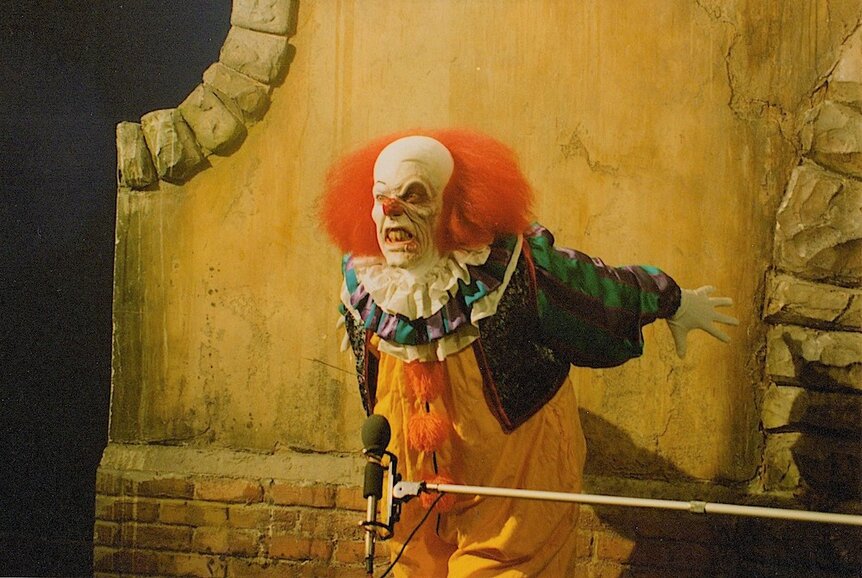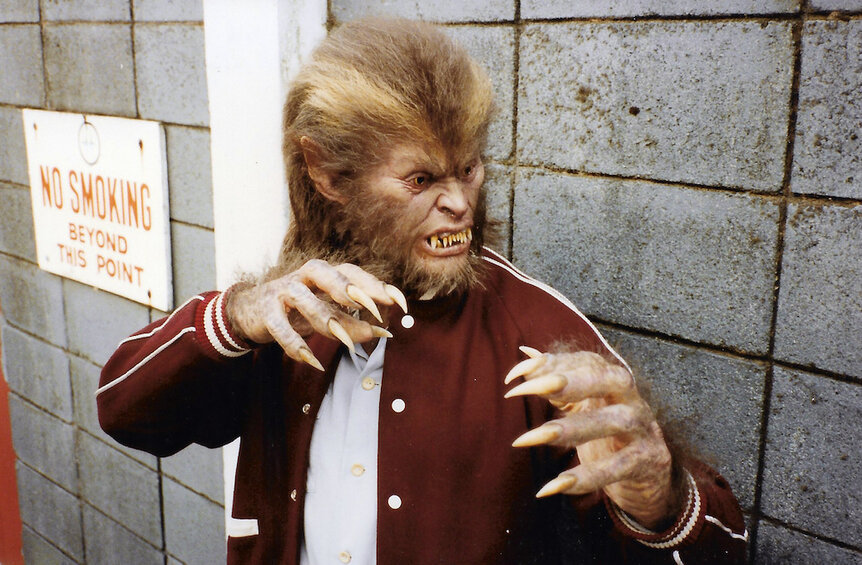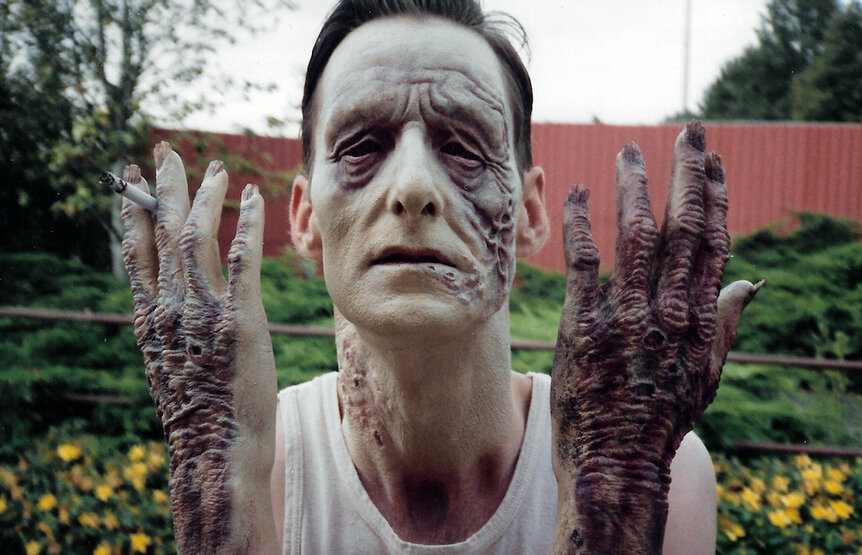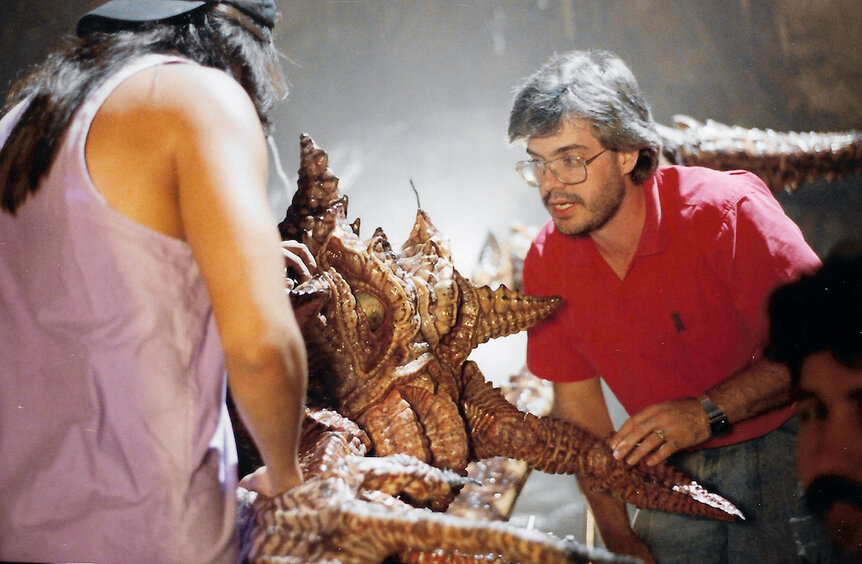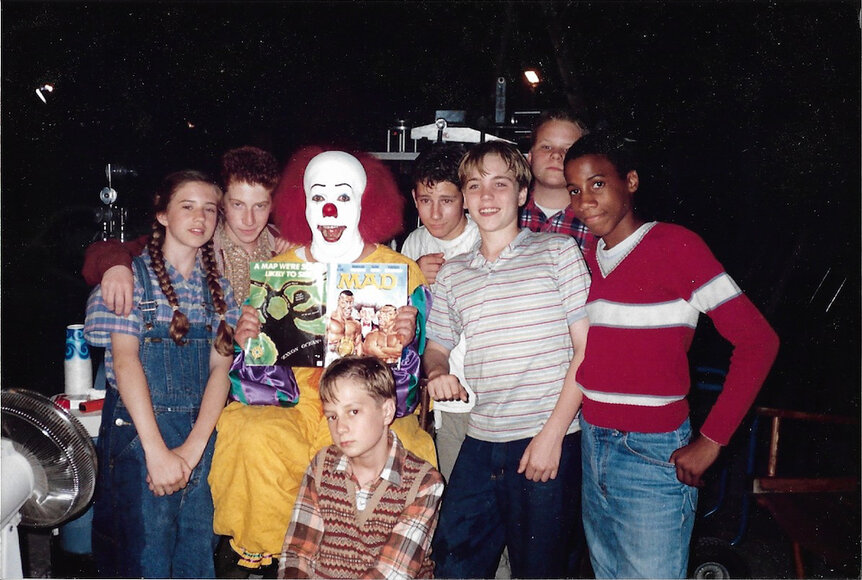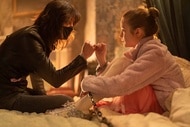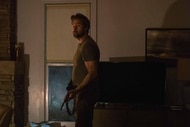Create a free profile to get unlimited access to exclusive videos, sweepstakes, and more!
We all float down here: Cast & crew of 'IT' miniseries reflect on Tim Curry's Pennywise in wake of new documentary
Curry's take on the Lovecraftian horror living below the streets of Derry is the definition of a definitive performance.
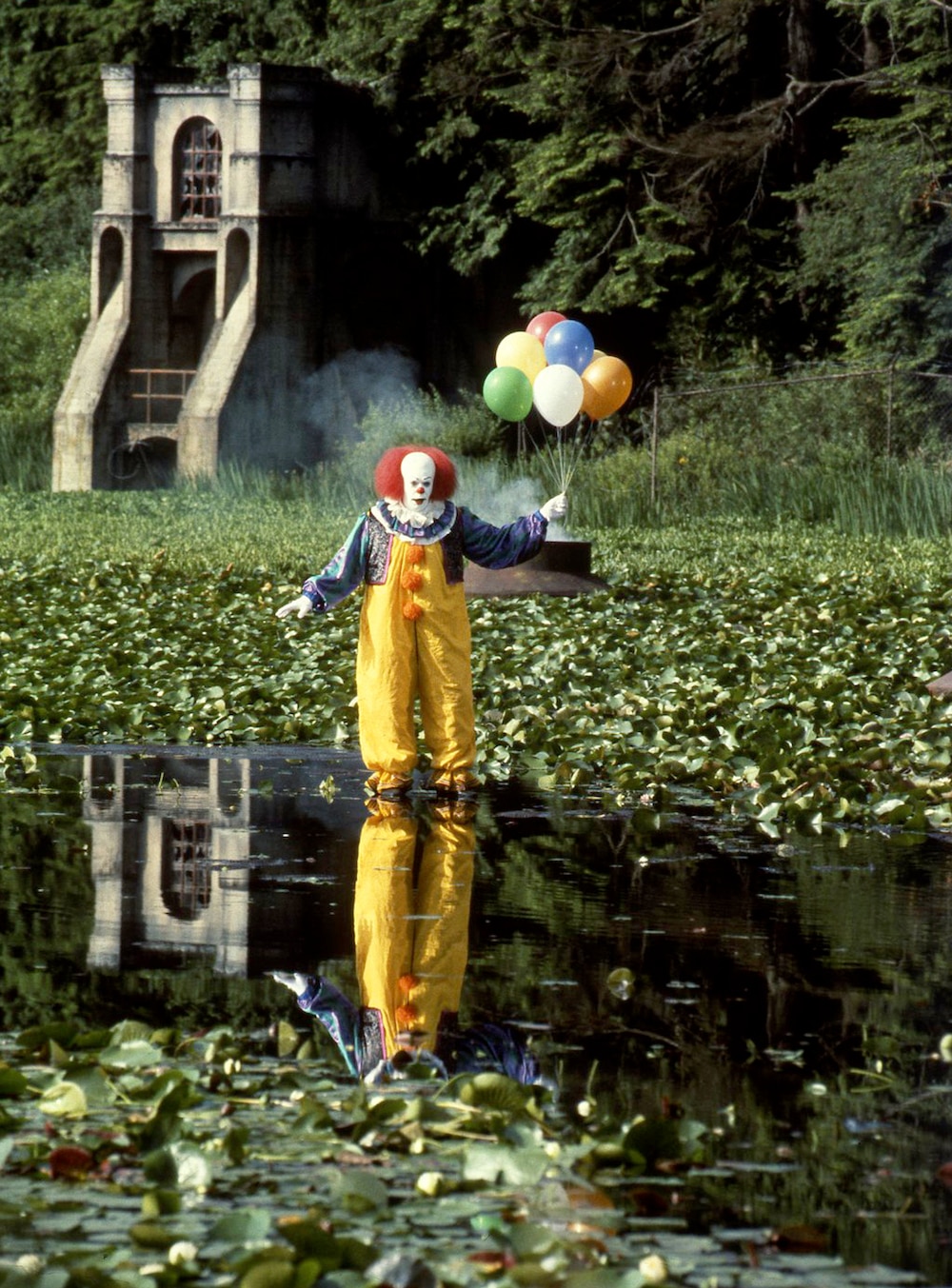
Pennywise the Dancing Clown, Bob Gray, the Deadlights. Whatever you want to call IT (pun intended), the child-devouring creature that dwells in the Macroverse and the sewers beneath Derry is, without question, one of the greatest (if not the greatest) monsters to ever pop out of Stephen King's twisted imagination and grace our cultural landscape.
The ingenious idea of an immortal, Lovecraftian being capable of assuming the shape of whatever scares us most effectively put a face — one smeared with white greasepaint and bloody rouge — to the horror genre at large. Drawing on the infinite wisdom of the great Turtle Maturin, King eerily summed up the dark corners of the unknown that constantly threaten to rip our sanity up from the roots in the same way a gardener clears out an infestation of weeds. The only antidote for this existential entropy, King argues, is the untainted innocence of childhood and friendship, which can sometimes shine a much-needed light into the infinite void of maddening darkness.
When Hollywood came knocking on IT's door with plans for a small screen adaptation, however, the entertainment industry found its match in the 1986 source material, a novel containing just over 1,000 pages and a plot spanning several eons. Much like the Deadlights, it was seemingly boundless and inscrutable. In addition to the conundrum of length — which ultimately prompted zombie godfather George A. Romero to throw up his hands in defeat — there was also a question of who could embody the entity that gives the book its chillingly ambiguous title. Did any actor alive have the chops needed to convey the terror of a pipe-dwelling clown without their performance veering into the realm of hyperbolic camp?
Yes, and that actor's name was Tim Curry — Dr. Frank-N-Furter himself! The veteran of Rocky Horror Picture Show and Clue emerged as the missing piece of the jigsaw puzzle for the 1990 miniseries adaptation directed by Tommy Lee Wallace (a filmmaker known for helming sequels in established horror franchises like Halloween and Fright Night). While the original adaptation of IT hasn't exactly aged well on a multitude of levels, it continues to stand the test of time "on the strength of Tim Curry's performance," the show's makeup and special effects artist, Bart Mixon, tells SYFY WIRE over Zoom. "What he did with Pennywise is why we’re here today."
With the miniseries celebrating its 32nd anniversary this fall, audiences can take a deep dive into its fascinating production via Pennywise: The Story of It, a two-hour documentary hailing from co-directors John Campopiano and Chris Griffiths. Currently streaming on Screambox, the long-gestating chronicle of the seminal television event features never-before-seen interviews with the surviving members of the cast and crew (Curry included), as well as two hours of behind-the-scenes footage shot by Mixon.
"I wanted to be part of this documentary because I love what we made and the cultural moment that it represents," says Seth Green, who played young Richie Tozier, the comic relief of the Losers Club. "And it's very cool to have filmmakers interested in organizing all of the footage that was shot. There's a lot of archival stuff that got shot while it was made. I love that these filmmakers were excited to put all that into something that you could watch. I was interested in memorializing this whole experience."
"There's a ton of stuff that, for me, I was like, ‘Wow, that's new information. I had no idea and never really would have thought about that,'" adds Ben Heller, who took on the role of young Stan Uris, the only member of the Losers not to return to Derry as an adult. "[You're] gonna find that there's some interesting anecdotes and stories that were happening on set that are going to maybe help to round out fans’ affinity for the movie."
Marlon Taylor, who played young Mike Hanlon (the Losers' future historian and only member of the group to remain in the town as an adult) sums it up best: "This documentary will make people feel more like Losers with us. It'll bring them into our world."
Despite the fact that they've been separated by time and space for the last three decades and change, the original representatives of the live-action Losers Club immediately snap into a comfortable repartee with each other over Zoom.
"I hadn't really spoken to any of these guys in years, except for the occasional like, ‘Hey, good to see you doing this kind of thing,’" admits Adam Faraizl, who portrayed the young version of Eddie Kaspbrak, the Losers' resident hypochondriac. "And then once the new movie started coming out, and the documentary started being filmed, and we started getting booked for conventions, that was the first time I really got to see all these kids in 30 years. That was pretty amazing."
If you didn't know any better, though, you'd think the group of actors has hung out every weekend since that magical Vancouver summer way back in 1990. "That was our '69, man," says Brandon Crane, who played the chunky, yet erudite, Ben Hanscom. "Even if it didn’t air, it still would have been an amazing exercise and an amazing summer."
As the only girl of the bunch, Emily Perkins (young Beverly Marsh), didn't understand many of the "jokes and elements of the camaraderie" enjoyed by her male co-stars. "I don't think I knew what masturbation was, my vocabulary expanded exponentially during that period," explains the Vancouver native. "All these boys were staying in a hotel and they were getting into all kinds of trouble — like throwing things off the balcony [and] renting things only adults should be renting... I really liked it when the boys were all goofing around and [director Tommy Lee Wallace] would get mad. Then he'd be like, ‘Except you Emily. You’re doing great.’"
Unfortunately, Jonathan Brandis — who played young Bill Denbrough — passed away in 2003 at the age of 27.
Tying the ensemble together was Curry, totally vanishing into the role of Pennywise via Mixon's iconic makeup effects, which resulted in one of the most legendary clowns in the history of pop culture. "I'd say Ronald McDonald and the original Bozo are probably two other big ones," Mixon says with a chuckle. "But I certainly won't argue with you."
Drawing inspiration from Lon Chaney's turn as the Phantom of the Opera in the 1925 siren film, Mixon hoped to depict the central antagonist as "a living cartoon" with no trace of relatable human features. "[With] a lot of clown makeups you see in movies, it's a clown-white makeup and if it's not on there heavy enough, [the actor's] skin tone shows through a little and it gets [to be] this weird, gray color. I didn't want that ... Consequently, we had to do a couple of layers of PAX [Paint] to opaque out his skin tone."
Mixon originally wanted to craft two looks for Pennywise: "When the kids saw him, he would be the harmless clown that we see in the movie [and] when the adults saw him, I wanted it to be a horrific caricature of a clown," he reveals. "Almost like a corpse-ish clown, where it would more skull-ish and more horrifying."
While that pitch never made it onto the screen, he did get a chance to delve into that sense of the macabre for the scene in which our young heroes spray the killer clown with imaginary battery acid. Hindered by budgetary and censorship limitations, Mixon "didn't build anything that didn't get used... everything that we made is on the screen."
His duties also extended to the various forms the entity takes in an effort to scare the Losers Club, including the contentious stop-motion spider featured in Part II's climax:
"Pennywise is a prosthetic makeup; Al Marsh is a prosthetic makeup; the werewolf is a mask; you got the head in the fridge; the mummy is its own thing; the animatronic spider was this huge undertaking that I thought we pulled off nicely. None of us had ever built anything that big before. So everything's different ... I think it's a sampler plate of various techniques and whatever worked best for that particular effect."
The makeup, however, was only half the battle. If Curry couldn't display a wide range of emotion through all that PAX Paint and latex "skull cap," the illusion would fall flat. It was fairly common to see the actor in full clown get-up, smoking one cigarette after another in between takes, but once Wallace called "Action!" the man truly became Pennywise — "100 percent all in," Taylor observes.
Crane compares Curry to "a hurricane" of unadulterated acting prowess. "The moment Tommy said, ‘Hey, let's try something... Okay, action!’ Boom! It's like, a nuke just went off. It sure made it easy for us. The amount of energy... I'd never experienced anything like that before."
"He was... exactly what you want an actor to be: committed, disciplined, creative, [and] fun," echoes Green. "He worked so hard and was brilliant and never complained. [He] set an incredible example for all of us — of how to persevere through insane conditions and how to be ready when they say ‘Action!’ I loved getting to be anywhere near him."
"The most memorable moment was just talking with him in between takes about what was gonna happen in the scene or getting some guidance from him on what a particular industry term meant that was being discussed on set," Heller remembers. "He was kind to me in those moments, and then a few minutes later, he's throwing me up against a wall. So, it was all over the place, but positive."
The IT miniseries drew an estimated 30 million viewers across both parts when it first aired in November of 1990. "I was like, ‘Excuse me? There were 30 million people in America in the ‘90s watching that? That's kind of insane,'" Faraizl says, later adding: "It kind of snuck in there, where it's dark and there's a lot of horror aspects to it. But as Stephen King tends to do, he does write very good children banding together and succeeding against overwhelming odds-type stories — and that's what we got to see. The horror aspects were almost tangential, at least in the way it was done. But that also doesn't mean it didn't scare the bejesus out of practically everyone who watched it."
"It's the first horror movie that a lot of kids saw, because it was on TV. Parents just assumed that it was appropriate for kids to watch," continues Perkins. "It's a coming-of-age story, so, in many ways, it is appropriate viewing for kids. It's just something that was a collective experience at that time in the early '90s. A lot of people just saw it and could relate to the characters."
The adult Losers were just as talented, with Richard Thomas (Bill), Annette O'Toole (Beverly), John Ritter (Ben), Harry Anderson (Richie), Dennis Christopher (Eddie), Tim Reid (Mike), and Richard Masur (Stan) returning picking up the narrative in Part II.
"It was all live effects — stop-motion and stuff, no CGI," explains Masur, who recently spoke with SYFY WIRE to celebrate the 40th anniversary of John Carpenter's The Thing. Despite the fact that Stan commits suicide before the group gets back together, poor Mr. Uris is unable to rest in peace. He becomes a twisted pawn in Pennywise's last-ditch attempt to deter the only mortals capable of bringing about his demise. Hoping to scare away the meddling kids like a Scooby-Doo! villain, the clown conjures up an image of Stan's disembodied noggin.
"I’m a severed head in a refrigerator," Masur explains. "I had the rack from a mini fridge, which they cut out. They cut [it] out and then put a piece on with a latex covering and they actually attached this thing to my neck. So I'm walking around with this thing around my neck for a whole day, waiting to shoot the scene. It was like the most incredibly uncomfortable thing I've ever been through."
Pennywise fittingly reawakened in 2017 — almost 27 years day after the miniseries — in a pair of R-rated feature film adaptations boasting larger budgets, modern-day visual effects, and serious studio backing from distributor, New Line Cinema. Helmed by Andy Muschietti, both projects brought in over $1 billion worldwide.
Similar to the television event that preceded it, the first movie centered around the Losers' first encounter with the malevolent entity during their youth, while the second chapter (released in September 2019) explored their pact to reunite as adults if the monster ever started killing again. In a minor break from the source material, Chapter One bumped up the timeline from the 1950s to the 1980s — perhaps in an effort to take advantage of the popularity of Stranger Things, which had premiered on Netflix the year before (it also didn't hurt that Finn Wolfhard would be playing young Tozier). This small change was enough to evoke serious nostalgia and déjà vu in some of the original actors.
"I love those kids and I love the energy that they had together because it was totally like us on set," Crane says. "It was that era, so I thought the humor just came home... They pulled it off. They did it without the benefit of adults, they did it without commercial breaks... I walked out of there like, ‘There’s room for both of us.'"
Having already left his indelible mark on Derry, Maine, the 71-year-old Curry wasn't about to retread similar territory by reprising Pennywise. But who could fill those "big clown shoes," as Faraizl aptly puts it? "When someone has done such an iconic performance, and you're like, ‘Hey, you get to be this person,’ it can go one of two ways. It can go horribly wrong or you can take it and be like, ‘I'm gonna have to do this my own way because otherwise, I'm gonna look foolish.’"
The answer to the clown conundrum turned out to be Bill Skarsgård, who brought a haunting aura to the character along with a 19th-century aesthetic. Whether you're a fan of the big screen Pennywise or not, there's no denying that he stands apart (and smartly so) from Curry's interpretation.
"I feel like he really poured 100 percent of himself into this role, and I just can't believe everything that he came up with to add to Pennywise’s updated characteristics and mannerisms," Heller says. "He was incredible [and I have] huge respect for him and for Andy and Barbara Muschietti for what they were able to do for this franchise. It's a pretty incredible achievement for them."
"Good on Andy for casting such a tall, long creature who can make himself so small and then also tower over everybody," Green adds. "Visually, it’s just flat-out terrifying."
Taylor agrees: "I thought his interpretation was very, very, scary. I really enjoyed the stuff that he could do with his face and his eyes. That kind of had me jacked up."
Perkins describes the two films as "a huge step up from the original low-budget made-for-TV kind of thing that we were involved in, which still has its own, different kind of value. "But it was really neat to see this story brought to life with a whole lot more resources. I thought they did a great job of making it totally its own thing and quite different from the original adaptation."
As fate would have it, the big screen translation of King's enduring villain falls more in line with what Mixon — who was briefly attached to Cary Fukunaga's version before the No Time to Die director bowed out in 2015 — hoped to achieve in the miniseries when it came to the adult Losers seeing a "more horrific" version of the kid-killing clown.
"I thought what they ended up with looked great ... I'm a little envious that they had a bigger canvas to work with and less restrictions," he admits. The makeup artist's only piece of constructive feedback on Skarsgård's performance is that the actor "looks too scary" from the very moment he pops out of the sewer to gnaw off the arm of young Georgie Denbrough. "The whole point of his illusion is to like lure children in and I think right out of the gate, he's just creepy as hell. So I don't think a kid would come within a mile of him."
Even with that small critique, Crane's philosophy still rings true: the world has enough space for two Derrys (soon to be three with a prequel series in development at HBO Max). And, it's all thanks to the 1990 miniseries, which proved that King's cumbersome — and slightly problematic — tome was adaptable. That a shape-shifting circus performer from another dimension with a taste for frightened human flesh could indeed scare audiences in a live-action format.
"We got to do something that's indelible, regardless of its current volume in current pop [culture]," Green concludes. "I think that's why people are interested in watching this doc, is to understand the experience behind it. The thing itself is valuable enough to have created a touch point for a very passionate fan base. And we're forever a part of that, and we need to share it with each other. I think that's the coolest."
Pennywise: The Story of IT is exclusively streaming on Screambox.
Looking for more Stephen King content that makes your spine tingle and blood curdle? Director Keith Thomas' adaptation of Firestarter is now streaming on Peacock alongside A Good Marriage and Stuck in Love — the latter of which features a rare cameo from the author himself.
